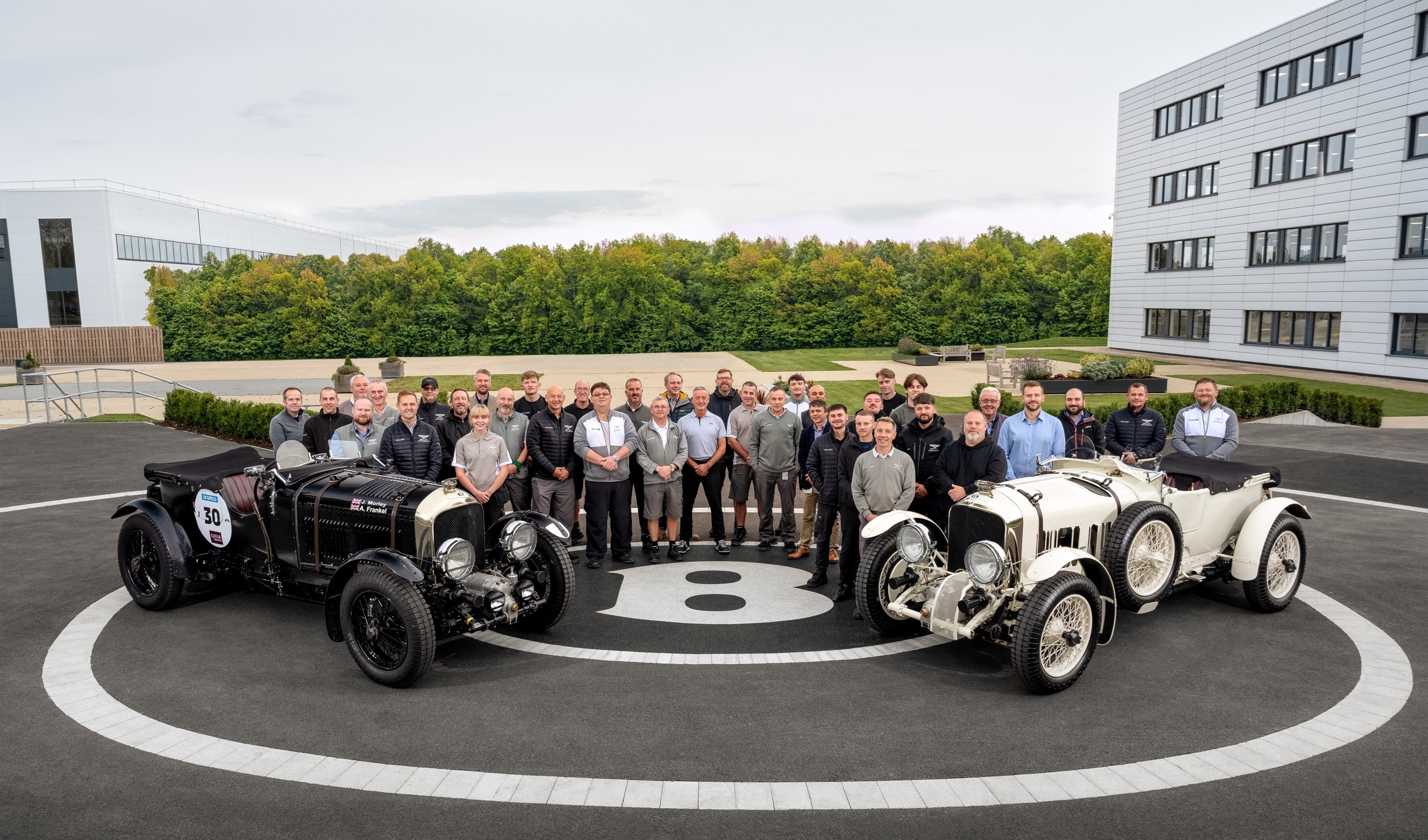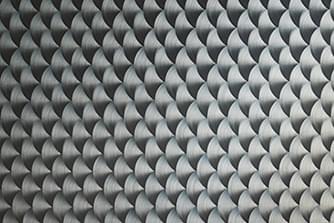
SPEED SIX CONTINUATION SERIES STARTS TESTING AS FINAL 4½ LITRE ‘BLOWER’ IS COMPLETED
SPEED SIX CONTINUATION SERIES STARTS TESTING AS FINAL 4½ LITRE ‘BLOWER’ IS COMPLETED
- Speed Six Continuation Series begins durability testing, following debuts of Car Zero and Factory Works cars
- Twelve-strong 4½ Litre ‘Blower’ Continuation Series completes build
- 8.000 km of dynamic driving to be completed to prove engineering quality
- Continuation Series based on original drawings and mechanics’ notes
- Original pre-war Works Bentleys used as master models to verify dimensions, materials and components
- Every car handcrafted from scratch using period-correct tools, fixings and techniques
- Speed Six to be thoroughly tested on track before work starts on 12 customer vehicles
- Each customer offered a personal fitting for their car, with choice of period correct exterior and interior finishes
(Crewe, 7 December 2023) The new Speed Six Continuation Series has begun its main testing phase before customer builds begin, after the completion of the final Blower Continuation Series customer car.
In period, the two cars raced as friendly rivals; the Supercharged 4½ Litre ‘Blowers’ were prepared and entered by the Hon Sir ‘Tim’ Birkin’s private team, while the Speed Six was Bentley’s winning works entry for Le Mans in 1929 and 1930. Today, the build and preparation of both cars come under one roof in the workshops of Mulliner – Bentley’s bespoke and coachbuilding division. With all customer Blowers now complete and delivered, Mulliner’s focus turns to their second continuation project, with the first two cars (Car Zero and Factory Works) undertaking months of static and dynamic testing.
The decision to create 12 Continuation Series models each of the 4½ Litre Supercharged ‘Blower’ and the 6½ Litre Speed Six was not taken lightly. As custodians of a brand with over a century at the pinnacle of performance and luxury, the team knew that their work would be judged to the highest standards.
Starting in 2020, a project team of Bentley Mulliner engineers, craftspeople and technicians worked closely with noted British specialists and suppliers to create the world’s first pre-war continuation series. The response from customers, the public, and the media has more than justified their painstaking care. After a development process that took tens of thousands of hours, Continuation Series models present exactly as the originals would have done in 1930, save for minor items where changes are required to avoid illegality.
The continuation projects have triggered the relearning of lost skills within Bentley, with technicians and artisans young and old now equipped with the knowledge and experience needed to build and maintain pre-war Bentleys.
One chapter ends…
As 2023 draws to a close, the final Blower Continuation Series customer cars have been delivered. While some customers have opted for the traditional Bentley racing team colour of Napier Green, others have exercised the choice that would have been available to Bentley owners in the late 1920s, including the last car which is finished in the customer’s own version of Old English White. Owners have been able to set their own preferred specifications in detail as part of a personal fitting service.
Birkin’s original Supercharged 4½ Litre – which came to be universally known as the ‘Blower’ – was built for racing, and so are the Continuation Series models. The Continuation Blower passed a rigorous inspection programme to qualify for an Historic Technical Passport, making it eligible to compete at FIA-sanctioned events for historic vehicles. This July, a works Bentley Blower – the company’s own Car Zero – once again took to the Le Mans circuit to race in the Le Mans Classic, a hugely emotional return for all who witnessed it.
…another chapter begins.
Meanwhile, work is in full swing on the next Continuation Series, the Speed Six. It takes two original Speed Sixes as its master model: the company’s own Speed Six, GU409, and ‘Old Number 3’, a works Speed Six driven in the 1930 Le Mans 24 Hour race by Sammy Davis and Clive Dunfee. The latter was generously loaned by its owner to provide the Mulliner team with invaluable data on dimensions, materials and components, down to the last screw, nut and bolt. The Mulliner Classic team is also indebted to the W.O. Bentley Memorial Foundation, which has provided 80% of the original drawings and notes used by the team. The Continuation cars will include modifications that were made by the Bentley works team to improve reliability and performance in the 1929 and 1930 Le Mans races; the works Speed Sixes won both races by a distance.
No detail has been overlooked. The Mulliner Classic team visited the National Motor Museum in Beaulieu, Hampshire, to verify the five authentic period Parsons Paints that will be available to customers. Over 600 individual new parts, including a new engine block casting, were fabricated for the new 6½ Litre race spec engine, which in period developed 200 bhp. Initial dyno testing has shown the Continuation Series engines to develop 205 bhp; higher outputs would be achievable with the aid of modern engineering materials (as many classic racing teams do) but the aim of the Continuation Series team is to create a Bentley exactly as it would have looked and performed in 1930.
Two Continuation Speed Six models, Car Zero and the Factory Works car, have already been built by Mulliner using a mixture of modern and traditional coachbuilding skills. One of the aims of the Continuation Series programme has been to pass precious skills on to the next generation and this is already bearing fruit. In the Mulliner workshops, skilled artisans with decades of experience can be seen working alongside young apprentices, helping to train the master craftspeople of the future. Each customer car will take 10 months to build, with deliveries commencing in 2025.
After its debut at the 2023 Goodwood Festival of Speed, Speed Six Car Zero has embarked on a test programme to achieve the equivalent of 35,000 kilometres of real-world driving across 8,000 kilometres of track driving. Intervals of gradually increasing duration and speed will check functionality and durability under the most challenging conditions. Meanwhile customers will enjoy a personal fitting service in the second car, the Speed Six Factory Works, to ensure they feel comfortable and in control at the wheel of their own models. As in the 1920s, owners of the Continuation Speed Six models will be able to have full confidence in their Bentley’s ability to cover long distances with reliability.
The Speed Six
A high-performance version of the 6½ Litre, the Speed Six became the most successful racing Bentley, winning Le Mans in 1929 and 1930 at the hands of Woolf Barnato, Sir Henry ‘Tim’ Birkin and Glen Kidston.
The Speed Six chassis was introduced in 1928 as a more sporting version of the 6½ Litre. The engine was modified to liberate more power, with twin SU carburettors, a higher compression ratio and a high-performance camshaft, responsible for an increase to 180 bhp. 182 Speed Six models were built between 1928 and 1930.
The racing version of the Speed Six was further developed, running a compression ratio of 6.1:1 and developing 200 bhp. Consecutive wins at Le Mans cemented the Speed Six’s place in Bentley history, with the 1929 victory setting a new benchmark for dominance at the race. Driven by Woolf Barnato and Sir Henry ‘Tim’ Birkin, a Speed Six led from the first lap until the chequered flag, followed by a procession of three other Bentleys. Birkin set a new lap record of 7:21 at an average speed of 83 mph, taking 46 seconds off the previous mark. The winning Speed Six also set a new distance record for the race at 2,844 km. Such a dominant performance by one manufacturer was not seen again at Le Mans for nearly 30 years.
- ENDS –







































